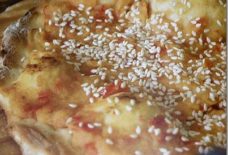Eid el-Fitr Celebrations Mark the End of Ramadan Around the World with Food and Traditions
Few festivals in the Muslim world are anticipated with greater delight than Eid el-Fitr. It is this festival that marks the end of the holy month of Ramadan, the annual assertion of ‘the spirit over the flesh’.
In Islam, believers are called upon to cease all consumption of food and drink between the hours of daylight for 30 consecutive days. This period is called Ramadan (Ramazan in Iran and Turkey, Ramzan in the Indian subcontinent). After dark during Ramadan, people may eat and drink as much as they wish.
Both the start and the finish of Ramadan coincide with the sighting of the new moon in the sky
Both the start and the finish of Ramadan coincide with the sighting of the new moon in the sky. Today, despite modern technology, the month of Ramadan may still begin and end on different days in different countries depending on the reliable sighting of the crescent moon.
There is a wide range of customs and traditions that mark the Eid el-Fitr celebrations in various countries in North Africa, the Middle and Far East and even in the Pacific, but in general it is looked upon as a day of family, rather than public celebration. The day always starts with special Eid prayers at the main mosque (also attended by the women in some countries), followed later in the day by a large celebratory lunch at the house of the senior member of the family. Everywhere children receive gifts of cash and new clothes.
Traditional dishes include rice dishes and specially prepared breads
Preparation for the festival often starts the day before and the entire celebration can last up to five days. In Bahrain, people even mark the half-way point in Ramadan. On the 15th day, children dress smartly and call at their friends’ and neighbours’ homes in the evening and are given sweets. On Eid el-Fitr itself, the family lunch will consist of biryani (a mixed rice dish of meat and spices), sago dishes, stuffed, sweet pastries (sambouseh), and other sweetmeats.
In Iraq, the family will enjoy a breakfast of buffalo cream with honey and bread before going on to the family lunch together. Here, a lamb may be sacrificed for the occasion, and a special Eid sweetmeat called klaicha, a date-filled pastry, is made.
Egypt sees four days of celebration, with preparations starting several days earlier. Special biscuits are made to give to friends and relatives on the day. The men will go to the mosque early in the morning, while the women start work on the preparation of the fish that will form the centrepiece of a great celebratory lunch.
In Palestine, in addition to prayers and family celebrations, a special sweetmeat, k’ak al-tamar, is made to serve with coffee.
In Somalia, a three-day celebration starts with a family lunch which includes rice mixed with meat and vegetables, and pasta accompanied by anjira (a thin bread prepared liked chapatti). Halva, which in Somalia is more like a cumin-flavoured custard, is also served, along with special fried (or baked) biscuits made of flour, sugar, oil, warm water and baking powder.
One of the special dishes in India, Pakistan and Fiji is savayya, a dish of fine, toasted vermicelli noodles, which is served for the first breakfast after the fast. Toasted vermicelli may be found in many ethnic stores in Britain, but it is easily made by browning fine vermicelli in a warm oven, or by dry-frying broken pieces in a frying pan until browned. It can then be boiled until soft, drained and mixed with creamy milk and sugar.
In Indonesia, the family lunch consists of dishes made of chicken, lamb or beef, but never fish
In Indonesia, the family lunch consists of dishes made of chicken, lamb or beef, but never fish which is too ubiquitous in Indonesia to be considered as a celebratory dish. The traditional sweet is lapis legit, a rich layered cake. Here, the celebrations will last for a whole month.
In Malaysia, three public holidays mark Eid, but the visiting and celebrations will also continue for a month. Festive dishes include ketupat (rice cooked in wrapped coconut leaves) and lemang (glutinous rice cooked in bamboo cane), served with beef rendang.
The one exception in all these celebrations is Iran where, although the day is marked as a public holiday, there are no specific dishes made to mark the occasion. This is perhaps because, unlike most Muslim countries, the climate varies widely from season to season, especially on the high Iranian plateau. The winters are very cold and the summers very hot, and the moveable feasts of the lunar calendar preclude the preparation of annual dishes.
In Iran, Ramadan moves back by ten or eleven days each year, and so there are few festive dishes marking Muslim days of celebration. Also, unlike most Muslim countries which follow the Sunni branch of Islam, Iran is Shi’a, a branch which tends to mark the Islamic festivals in a different and less celebratory way. In the case of Ramazan, the breaking of the fast is quite a personal event. Those who have fasted will go to the mosque to attend special prayers, and those close to them will congratulate them on their successful fast.
The end of the fast
The spiritual well-being experienced at the end of the fast is celebrated, mostly with feasting but sometimes simply with quiet satisfaction.
Margaret Shaida
BBC News Service



